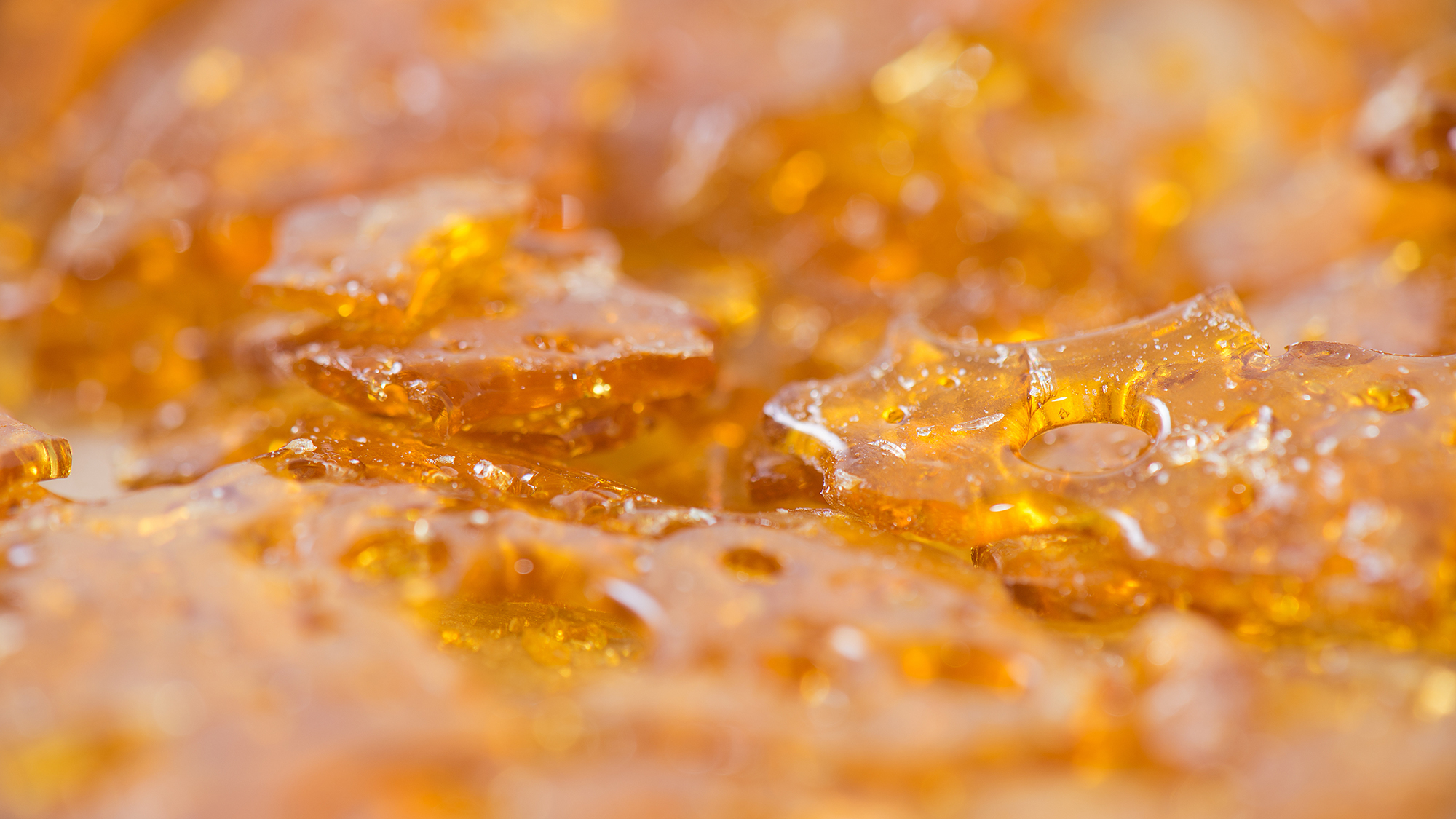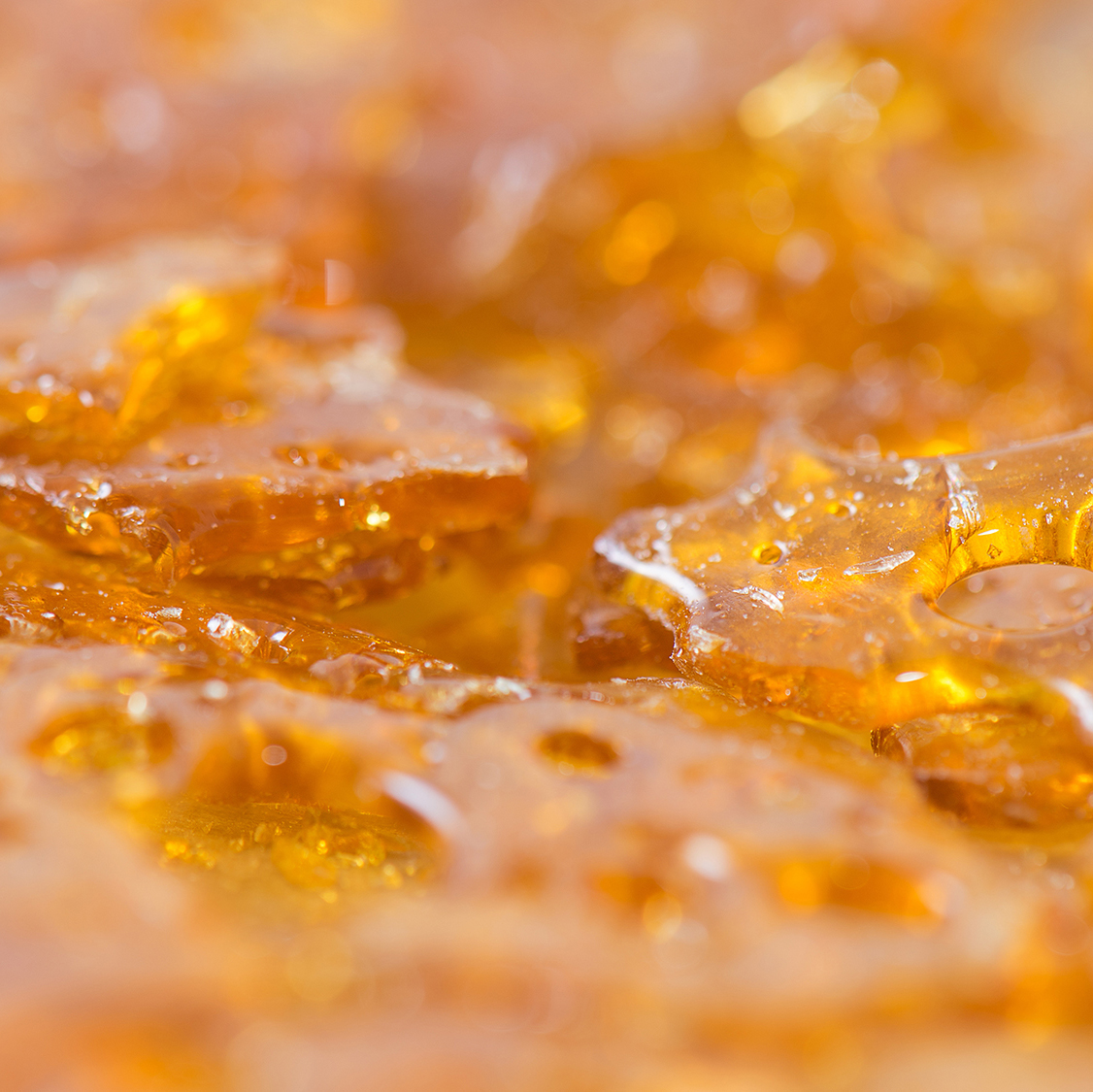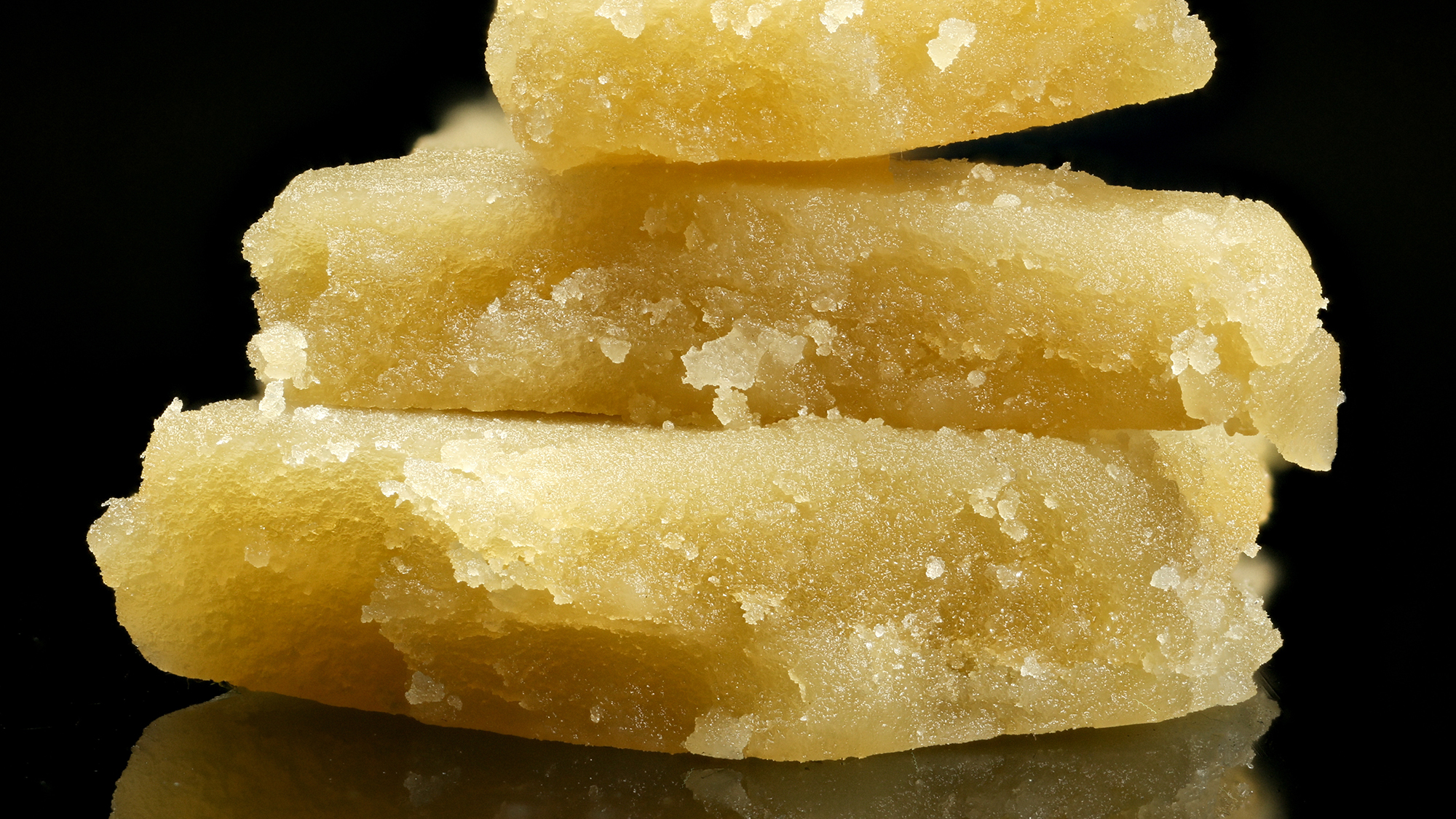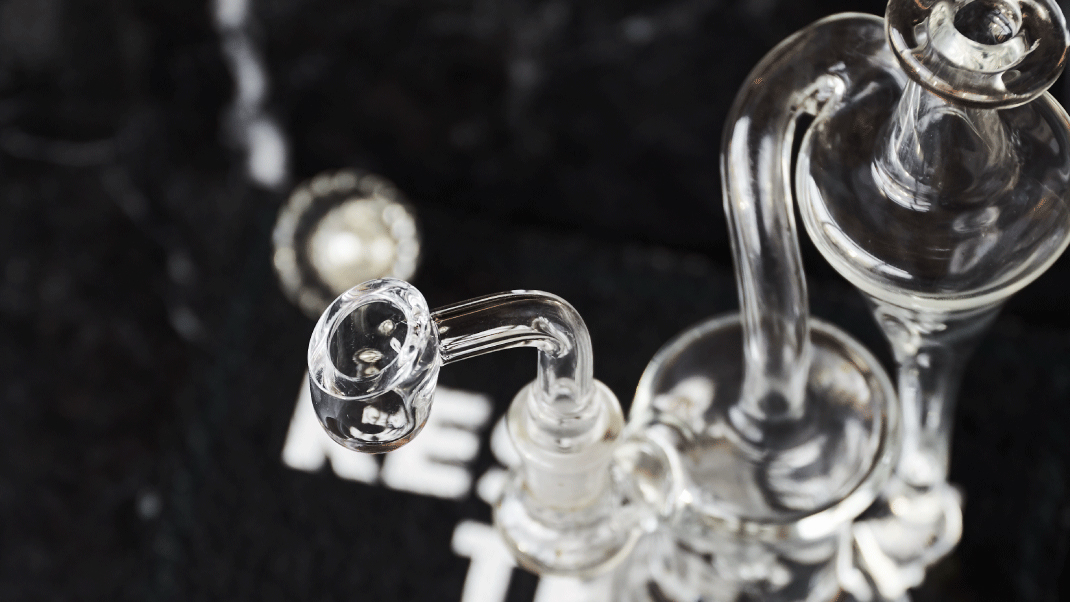Cannabis concentrates can be divided into two main categories – solventless and solvent-based. In this article, we explore the differences (and similarities) between the two and explain the different formats available.
Solventless Concentrates vs. Solvent-Based Concentrates
The two categories of concentrates, solventless and solvent-based, are distinguished from one another by the extraction method used to create the product.
Solvent-based products are made using an external solvent. A solvent can be defined as a chemical compound that turns a solid into a liquid-like solution. In solvent-based concentrates, a solvent is used to strip the trichomes (containing the terpenes and cannabinoids) from the cannabis plant to be used in a consumable extract. Common examples of solvents include butane, propane, C02 and alcohol.
Solventless products, on the other hand, are created through a process that removes trichomes from the cannabis plant without the use of an external solvent, typically by using agitation, heat, pressure or a combination of these methods.

What are the different types of Solvent-Based Concentrates?
Solvent-based concentrates are named after their appearance, texture and consistency and/or their extraction methods.
Shatter
Shatter can be made with various solvents but the most common method is through a butane hash oil (also known as BHO) extraction process. Other lesser-known solvents such as liquefied petroleum gases (LPG) and ethanol can also be used to make shatter.
Shatter derives its name from its hard, brittle consistency, producing a product that will “shatter” if manipulated. This concentrate is typically semi-transparent and can range in colour from dark amber to bright gold. It is one of the most popular and common forms of solvent-based concentrates. When exposed to heat and light, shatter’s consistency begins to change and can be manipulated and transformed into budder and wax-like concentrates.
Budder
A concentrate that originated in Canada, budder is a from of cannabis wax and has a soft but solid consistency. Budder is typically made through a Butane Hash Oil (BHO) extraction method. They are then purged at a higher temperature while being whipped like a batter. That’s why you may also see these concentrates being referred to as batter and badder.
Live Resin/Sauce
Unlike the previously mentioned solvent-based concentrates, live resin (or sauce/diamonds/caviar) is made from plant material that hasn’t been dried or cured. Plants are harvested and are instantly frozen, which helps preserve the most desirable compounds and retain the full flavor of the cannabis plant. Then this fresh frozen material is run through an extraction process, typically BHO, resulting in high-quality and flavourful extracts. High Terpene Full Spectrum Extracts (HTFSE) and High Cannabinoid Full Spectrum Extracts are also commonly referred to as sauce, depending on the consistency.
Distillate
Distillate-makers use an extraction process that effectively separates and refines molecules and contaminants to create a clean, almost completely clear concentrate. Distillate typically contains a higher THC (or CBD) potency than other types of concentrates and is heralded for being “pure”. However, the distillate extraction method completely removes all terpenes, resulting in a concentrate that does not contain all of the full plant benefits of cannabis. Distillate can be dabbed, vaporized and can even be eaten raw (or infused into edibles) since the contained THC is already activated.
C02 Oil
C02 oil, sometimes referred to as honey oil, is a solvent-based cannabis concentrate that is made with Carbon Dioxide (C02). The process is efficient and yields pure and clean product with a more “natural” solvent. The resulting extract is usually an amber-coloured liquid-like oil that can be dabbed, vaporized or used in pre-filled vaporizable cartridges.
What are the different types of Solventless Concentrates?
Solventless concentrates are named after the extraction process utilized to create the product.
Flower Rosin & Hash Rosin
Rosin is a solventless concentrate that comes in a variety of colours and consistencies. It can be made from any cannabis starting material including nugs, loose shake and even physically concentrated extracts like hash and kief. The former is referred to as “flower rosin” while the latter is called “hash rosin”.
Rosin is created by pressing your chosen cannabis material between two hot surfaces with pressure for a specific amount of time, which results in resinous sap being squeezed out of the plant material. The result is typically an extract with a sappy texture and translucent color. If rosin is made correctly, it will retain the flavour, aroma and terpenes of the original flower. This process can be compared to squeezing the juice out of a fruit or the oil out of an olive.
Kief
Kief, a word derived from the Arabic language meaning ‘pleasure’, refers to the resinous trichomes of cannabis that may accumulate in containers or are sifted from loose, dry cannabis with a mesh screen or sieve. Some cannabis enthusiasts will use a multi-compartment herb grinder to collect the trichomes that fall off of cannabis buds as they are milled. This collection of trichomes, or “kief”, can then be consumed in a variety of ways. Kief can be added to cannabis flower in bowls, joints and blunts for an extra kick of cannabinoids. Additionally, kief can be used as starting material and extracted into hash or rosin using techniques that apply heat and pressure to the substance.
Traditional Hash
Traditional-style hash is often named after the region or country of origin. The most common countries that hashish comes from are Morocco, Nepal, India, Pakistan and Afghanistan. Now, hashish is being manufactured legally in Canada. This form of solventless concentrate typically possesses between 5-40% THC depending on the potency of the starting material and the effectiveness of the extraction process.
Traditional-style hashish can be smoked, combined with cannabis flower and/or used in the cooking and baking of infused edibles.
Dry Sift Hash
Dry sift hash is a form of solventless concentrate that derives its name from the process used to make it. The dry sift technique involves using screens with fine mesh to hand-sift the dried cannabis buds, removing the cannabinoid-filled trichome glands. The end result is an extract with a granular-like consistency.
Dry sift is a versatile substance that can be consumed in a number of ways. Similar to kief, dry sift hash can be pressed into rosin or turned into traditional-style hash. Dry sift can also be added to any joint, blunt or bowl for additional potency.
Bubble Hash
Bubble hash, also known as ice water hash, ice wax sift or wet sift, is a cannabis concentrate comprised of trichomes (resin glands) that have been separated from the plant using ice and water, agitation and a sieve. The resinous trichomes freeze and break off of the plant matter, sinking to the bottom of a metal sieve, usually within a series of mesh screens, each with a diminishing sized mesh. The finer the mesh, or “micron,” the finer the material and lesser the plant matter. Bubble hash gets its name from the way that it bubbles when exposed to flame. This form of hash is commonly consumed through dabbing, but similarly to the other types of hashish, can also be added to flower for increased potency.
Live Rosin
Live rosin is a unique solventless extract that is made by pressing bubble hash ,made from freshly harvested and frozen cannabis, in a rosin press at a specific temperature, pressure and period of time. The result is a much lighter coloured sap-like extract that does not contain any unwanted plant material. Using top quality bubble hash will achieve “full melt” status, meaning it fully dissolves when heated vs. leaving residue behind. . Consumers enjoy live rosin for its robust and and incredibly pungent terpene profiles.
The Evolution of Concentrates
Solvent-based extracts have been the popular choice among concentrate enthusiasts for the past few decades. However, more recently, there has been a movement towards solventless techniques and products. Solventless products such as flower rosin have become increasingly popular as they are seen as a cleaner and more natural option, since there is no risk of consuming residual solvents.
There has been a lot of innovation in cannabis concentrates over the last ten years. Most of the concentrates we know today were created and popularized during a ten year period, between 2010 and 2020, including live resin, diamonds, sauce, distillate, isolate and more.
Now that concentrates are becoming more well known and are legally manufactured and available throughout Canada, that innovation will continue.




